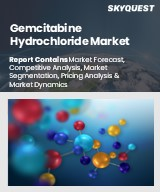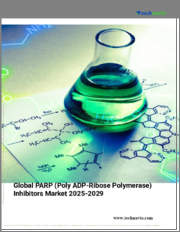
|
시장보고서
상품코드
1796128
염산 젬시타빈 시장 규모, 점유율, 성장 분석 : 유형별, 용도별, 유통 채널별, 지역별 - 산업 예측(2025-2032년)Gemcitabine Hydrochloride Market Size, Share, and Growth Analysis, By Type (Branded, Generic), By Application (Pancreatic Cancer, Non-Small Cell Lung Cancer), By Distribution Channel, By Region - Industry Forecast 2025-2032 |
||||||
세계의 염산 젬시타빈 시장 규모는 2023년에 22억 달러로 평가되며, 2024년 23억 3,000만 달러에서 2032년에는 36억 2,000만 달러로 성장하며, 예측 기간(2025-2032년)의 CAGR은 5.7%로 성장할 전망입니다.
세계의 염산 젬시타빈 시장은 특히 췌장암, 난소암, 폐암, 유방암 등 암 발병률이 크게 증가함에 따라 주도하고 있습니다. 염산 젬시타빈은 다양한 고형암에 대한 화학요법 요법의 중요한 컴포넌트로서 암 치료에 필수적인 역할을 하고 있습니다. 인구 고령화, 생활습관 변화, 환경적 위험 등의 요인이 암 발병률 증가와 효과적인 치료법에 대한 수요 증가에 기여하고 있습니다. 신흥 국가에서는 진단율, 의료 접근성, 화학요법 이용률이 향상되고 있으며, 이는 시장 성장을 더욱 촉진하고 있습니다. 약물 제제, 리포좀 전달 시스템, 병용요법의 기술 혁신은 의사의 사용과 환자의 적격성을 높이고 있습니다. 특허 만료 후 제네릭 의약품의 부상으로 환자 접근성이 확대되고, 의료비 지출 증가와 개인 맞춤형 종양학으로의 전환은 지역 간 시장 확대를 지속할 것으로 보입니다.
목차
서론
- 조사의 목적
- 조사 범위
- 정의
조사 방법
- 정보 조달
- 2차와 1차 데이터 방법
- 시장 규모 예측
- 시장의 전제조건과 제한
개요
- 세계 시장 전망
- 공급과 수요 동향 분석
- 부문별 기회 분석
시장 역학과 전망
- 시장 개요
- 시장 규모
- 시장 역학
- 촉진요인과 기회
- 억제요인과 과제
- Porter의 산업 분석
주요 시장 인사이트
- 주요 성공 요인
- 경쟁의 정도
- 주요 투자 기회
- 시장 에코시스템
- 시장의 매력 지수(2024년)
- PESTEL 분석
- 거시경제 지표
- 밸류체인 분석
- 가격 분석
- 사례 연구
염산 젬시타빈 시장 규모 : 유형별, CAGR(2025-2032년)
- 시장 개요
- 선발품
- 제네릭 염산 젬시타빈
염산 젬시타빈 시장 규모 : 용도별, CAGR(2025-2032년)
- 시장 개요
- 췌장암
- 비소세포 폐암
- 유방암
- 기타
염산 젬시타빈 시장 규모 : 유통 채널별, CAGR(2025-2032년)
- 시장 개요
- 병원 약국
- 소매 약국
- 온라인 약국
염산 젬시타빈 시장 규모 : 지역별, CAGR(2025-2032년)
- 북미
- 미국
- 캐나다
- 유럽
- 독일
- 스페인
- 프랑스
- 영국
- 이탈리아
- 기타 유럽 지역
- 아시아태평양
- 중국
- 인도
- 일본
- 한국
- 기타 아시아태평양
- 라틴아메리카
- 브라질
- 기타 라틴아메리카 지역
- 중동 및 아프리카
- GCC 국가
- 남아프리카공화국
- 기타 중동 및 아프리카
경쟁 정보
- 상위 5사의 비교
- 주요 기업의 시장 포지셔닝(2024년)
- 주요 시장 기업이 채택한 전략
- 최근 시장 동향
- 기업의 시장 점유율 분석(2024년)
- 주요 기업의 기업 개요
- 기업의 상세
- 제품 포트폴리오 분석
- 기업의 부문별 점유율 분석
- 매출의 전년대비 비교(2022-2024년)
주요 기업 개요
- Eli Lilly and Company(USA)
- Teva Pharmaceutical Industries Ltd.(Israel)
- Pfizer Inc.(USA)
- Mylan N.V.(USA)
- Fresenius Kabi AG(Germany)
- Accord Healthcare(United Kingdom)
- Sun Pharmaceutical Industries Ltd.(India)
- Dr. Reddy's Laboratories(India)
- Cipla Ltd.(India)
- Aurobindo Pharma(India)
- Sandoz International GmbH(Germany)
결론과 제안
KSA 25.09.01Global Gemcitabine Hydrochloride Market size was valued at USD 2.2 billion in 2023 and is poised to grow from USD 2.33 billion in 2024 to USD 3.62 billion by 2032, growing at a CAGR of 5.7% during the forecast period (2025-2032).
The global market for Gemcitabine Hydrochloride is being driven by a significant increase in cancer incidence, particularly in pancreatic, ovarian, lung, and breast cancers. As a vital component of chemotherapy regimens for various solid tumors, Gemcitabine Hydrochloride has become essential in oncology treatment. Factors like aging populations, lifestyle changes, and environmental risks contribute to rising cancer rates and demand for effective therapies. Emerging economies are witnessing improved diagnosis rates, healthcare access, and chemotherapy utilization, further promoting market growth. Innovations in drug formulations, liposomal delivery systems, and combination therapies are enhancing both physician use and patient eligibility. The advent of generics post-patent expirations has broadened patient access, while escalating healthcare expenditures and a shift towards personalized oncology are set to sustain market expansion across regions.
Top-down and bottom-up approaches were used to estimate and validate the size of the Global Gemcitabine Hydrochloride market and to estimate the size of various other dependent submarkets. The research methodology used to estimate the market size includes the following details: The key players in the market were identified through secondary research, and their market shares in the respective regions were determined through primary and secondary research. This entire procedure includes the study of the annual and financial reports of the top market players and extensive interviews for key insights from industry leaders such as CEOs, VPs, directors, and marketing executives. All percentage shares split, and breakdowns were determined using secondary sources and verified through Primary sources. All possible parameters that affect the markets covered in this research study have been accounted for, viewed in extensive detail, verified through primary research, and analyzed to get the final quantitative and qualitative data.
Global Gemcitabine Hydrochloride Market Segments Analysis
Global Gemcitabine Hydrochloride Market is segmented by Type, Application, Distribution Channel and region. Based on Type, the market is segmented into Branded and Generic. Based on Application, the market is segmented into Pancreatic Cancer, Non-Small Cell Lung Cancer, Breast Cancer and Others. Based on Distribution Channel, the market is segmented into Hospital Pharmacies, Retail Pharmacies and Online Pharmacies. Based on region, the market is segmented into North America, Europe, Asia Pacific, Latin America and Middle East & Africa.
Driver of the Global Gemcitabine Hydrochloride Market
The increasing prevalence of cancer worldwide, particularly in cases such as pancreatic, lung, breast, and bladder cancers, significantly fuels the growth of the gemcitabine hydrochloride market. Its extensive efficacy and favorable safety profile have established gemcitabine hydrochloride as a fundamental component in cancer treatment regimens. Additionally, the ongoing research into new applications and the exploration of combination therapies involving gemcitabine further enhances its demand. As healthcare providers seek effective treatment solutions, the robust clinical interest surrounding this drug will likely contribute to sustained market progression, highlighting its vital role in oncology pharmacotherapy.
Restraints in the Global Gemcitabine Hydrochloride Market
The global market for gemcitabine hydrochloride faces significant constraints due to the expiration of patents on branded formulations, which has resulted in a surge of generic alternatives. This influx has intensified price competition, leading to reduced profitability for original manufacturers as they grapple with decreasing prices. While the availability of more competing products enhances accessibility for patients, it simultaneously places financial pressure on companies, potentially stifling innovation and investment in the development of new indications or improved delivery methods. As a result, these factors may hinder the growth and penetration of the gemcitabine hydrochloride market on a global scale.
Market Trends of the Global Gemcitabine Hydrochloride Market
The Global Gemcitabine Hydrochloride market is witnessing a significant trend towards the adoption of Artificial Intelligence (AI) in personalized chemotherapy. Key players are leveraging advanced AI and data analytics to enhance treatment planning, focusing on real-time patient monitoring and predictive modeling. This innovative approach aims to optimize individualized dosing plans, ensuring a more accurate and effective delivery of cancer treatment. As healthcare providers increasingly recognize the potential of AI to improve patient outcomes, the integration of these technologies in Gemcitabine Hydrochloride therapies is expected to drive market growth, transforming how cancer treatments are tailored to meet specific patient needs.
Table of Contents
Introduction
- Objectives of the Study
- Scope of the Report
- Definitions
Research Methodology
- Information Procurement
- Secondary & Primary Data Methods
- Market Size Estimation
- Market Assumptions & Limitations
Executive Summary
- Global Market Outlook
- Supply & Demand Trend Analysis
- Segmental Opportunity Analysis
Market Dynamics & Outlook
- Market Overview
- Market Size
- Market Dynamics
- Drivers & Opportunities
- Restraints & Challenges
- Porters Analysis
- Competitive rivalry
- Threat of substitute
- Bargaining power of buyers
- Threat of new entrants
- Bargaining power of suppliers
Key Market Insights
- Key Success Factors
- Degree of Competition
- Top Investment Pockets
- Market Ecosystem
- Market Attractiveness Index, 2024
- PESTEL Analysis
- Macro-Economic Indicators
- Value Chain Analysis
- Pricing Analysis
- Case Studies
Global Gemcitabine Hydrochloride Market Size by Type & CAGR (2025-2032)
- Market Overview
- Branded
- Generic Gemcitabine Hydrochloride
Global Gemcitabine Hydrochloride Market Size by Application & CAGR (2025-2032)
- Market Overview
- Pancreatic Cancer
- Non-Small Cell Lung Cancer
- Breast Cancer
- Others
Global Gemcitabine Hydrochloride Market Size by Distribution Channel & CAGR (2025-2032)
- Market Overview
- Hospital Pharmacies
- Retail Pharmacies
- Online Pharmacies
Global Gemcitabine Hydrochloride Market Size & CAGR (2025-2032)
- North America (Type, Application, Distribution Channel)
- US
- Canada
- Europe (Type, Application, Distribution Channel)
- Germany
- Spain
- France
- UK
- Italy
- Rest of Europe
- Asia Pacific (Type, Application, Distribution Channel)
- China
- India
- Japan
- South Korea
- Rest of Asia-Pacific
- Latin America (Type, Application, Distribution Channel)
- Brazil
- Rest of Latin America
- Middle East & Africa (Type, Application, Distribution Channel)
- GCC Countries
- South Africa
- Rest of Middle East & Africa
Competitive Intelligence
- Top 5 Player Comparison
- Market Positioning of Key Players, 2024
- Strategies Adopted by Key Market Players
- Recent Developments in the Market
- Company Market Share Analysis, 2024
- Company Profiles of All Key Players
- Company Details
- Product Portfolio Analysis
- Company's Segmental Share Analysis
- Revenue Y-O-Y Comparison (2022-2024)
Key Company Profiles
- Eli Lilly and Company (USA)
- Company Overview
- Business Segment Overview
- Financial Updates
- Key Developments
- Teva Pharmaceutical Industries Ltd. (Israel)
- Company Overview
- Business Segment Overview
- Financial Updates
- Key Developments
- Pfizer Inc. (USA)
- Company Overview
- Business Segment Overview
- Financial Updates
- Key Developments
- Mylan N.V. (USA)
- Company Overview
- Business Segment Overview
- Financial Updates
- Key Developments
- Fresenius Kabi AG (Germany)
- Company Overview
- Business Segment Overview
- Financial Updates
- Key Developments
- Accord Healthcare (United Kingdom)
- Company Overview
- Business Segment Overview
- Financial Updates
- Key Developments
- Sun Pharmaceutical Industries Ltd. (India)
- Company Overview
- Business Segment Overview
- Financial Updates
- Key Developments
- Dr. Reddy's Laboratories (India)
- Company Overview
- Business Segment Overview
- Financial Updates
- Key Developments
- Cipla Ltd. (India)
- Company Overview
- Business Segment Overview
- Financial Updates
- Key Developments
- Aurobindo Pharma (India)
- Company Overview
- Business Segment Overview
- Financial Updates
- Key Developments
- Sandoz International GmbH (Germany)
- Company Overview
- Business Segment Overview
- Financial Updates
- Key Developments



















